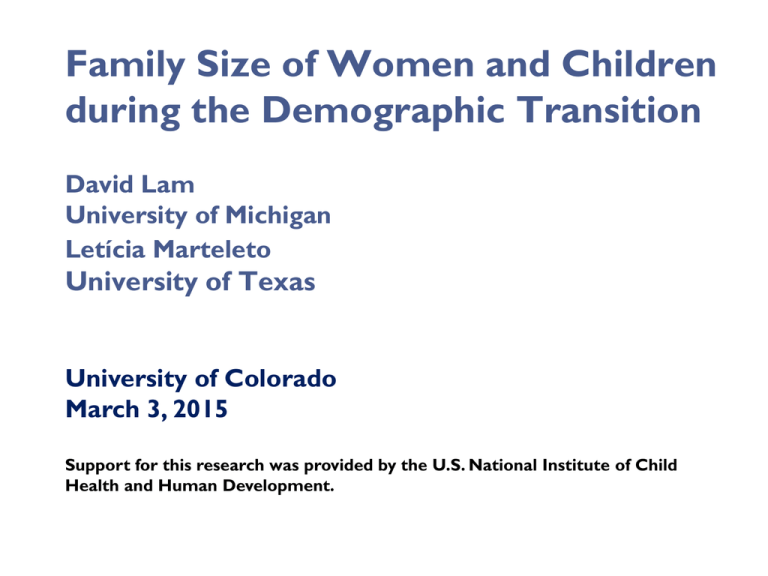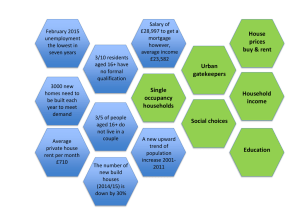Family Size of Women and Children during the Demographic Transition
advertisement

Family Size of Women and Children during the Demographic Transition David Lam University of Michigan Letícia Marteleto University of Texas University of Colorado March 3, 2015 Support for this research was provided by the U.S. National Institute of Child Health and Human Development. Family size and cohort size • This paper is a sequel to previous papers looking at family size and cohort size during the demographic transition: • David Lam and Letícia Marteleto, “Stages of the Demographic Transition from a Child’s Perspective: Family Size, Cohort Size, and Children’s Resources,” Population and Development Review, June 2008, 34(2): 225-252. • David Lam and Letícia Marteleto, “Small Families and Large Cohorts: The Impact of the Demographic Transition on Schooling in Brazil,” in The Changing Transitions to Adulthood in Developing Countries, National Academies Press, Washington, DC, 2006, pp. 56-83. • We showed that family size declines while cohort size increases during a long period of the demographic transition – 20 to 30 years in most countries. During this period competition for resources within families is declining, while competition with cohort members is increasing. Number of surviving siblings of 9-11-year-olds and total number of 9-11-year-olds in population, Brazilian censuses 1960-2000 6.0 250 Number of surviving siblings of 9-11 year-olds 200 4.0 150 3.0 Total number aged 9-11 in population 100 2.0 1.0 Stage 1, rising fam ily size and cohort size Stage 2, falling fam ily size and rising cohort size Stage 3, falling fam ily size and cohort size 0.0 1960 Cohort size (1960=100) Number of siblings 5.0 50 0 1965 1970 1975 1980 1985 1990 1995 2000 David Lam and Letícia Marteleto, “Stages of the Demographic Transition from a Child’s Perspective: Family Size, Cohort Size, and Children’s Resources,” Population and Development Review, June 2008. Purpose of this paper • How are changes in the family size of children related to changes in fertility during the demographic transition? • This is important if children are competing for resources with siblings. • While it may seem obvious that children’s family size will fall when fertility declines, they do not need to fall at the same rate or even change in the same direction. • We expand on Preston (1976) and study a large number of countries during the demographic transition. • We also look at the inequality in family size, extending Preston’s results. Distribution of family size for women Number of children surviving to women aged 45-49, Brazil 1960 0.12 Women (mean=4.5) Density 0.1 0.08 0.06 0.04 0.02 0 0 1 2 3 4 5 6 7 8 9 10 11 12 13 14 15 Number of children Children’s family size as a function of women’s family size fw(s)=pdf for family size of women aged 45-49 fc(s)=pdf for family size of children of women aged 45-49 sW = mean family size for women aged 45-49 sfW ( s ) sfW ( s ) fC ( s) n sW sf ( s ) ds W 0 fC ( s ) fW ( s ) if s sW fC ( s ) fW ( s ) if s sW fC ( s ) fW ( s ) if s sW Mean family size of women and children Number of children surviving to women aged 45-49, Brazil 1960 0.14 Women (Mean=4.5) Children (Mean=7.1) 0.12 Density 0.1 0.08 0.06 0.04 0.02 0 0 1 2 3 4 5 6 7 8 9 10 11 12 13 14 15 Number of children Sam Preston, Family Sizes of Children and Family Sizes of Women,” Demography 1976 sW = mean family size for women aged 45-49 W = standard deviation of family size for women aged 45-49 sC = mean family size of their children n sW s fW ( s )ds fC ( s) 0 n sfW ( s ) sC s f C ( s )ds s n ds sf ( s )ds 0 0 0 W n n n sC 2 s fW (s)ds 0 sW n 2 2 2 s s f ( s ) ds s W W W fW (s)ds 0 0 sW W2 sW sW Sam Preston, Family Sizes of Children and Family Sizes of Women,” Demography 1976 sW = mean family size for women aged 45-49 W = standard deviation of family size for women sC = mean family size of their children W2 sC sW sW (1) CVW = coefficient of variation of women’s family size ( W / sW ) W2 sC sW 1 2 sW 2 s (1 CV W W) (2) Fertility can decline without a decrease in mean family size for children Case 1: Before fertility decline 50% of women have 2 children 50% of women have 6 children Mean family size for women = 1/2*2 +1/2*6 = 4.0 Mean family size for children = 2/8*2 + 6/8*6=0.5+4.5 = 5.0 Case 2: After fertility decline 50% of women have no children 50% of women have 6 children Mean family size for women = 1/2*0 +1/2*6 = 3.0 (decrease of 1) Mean family size for children = 6.0 (increase of 1) Implications of Preston’s result sC sW (1 CVW2 ) (2) • Mean children’s family size is always greater than mean women’s family size, as long as there is any variance in fertility • Fertility decline and family size: – If CV goes up while mean fertility declines, children’s family size will decline more slowly than women’s family size • Comparing subgroups: – If a group with higher fertility also has a higher CV, then the difference in family size of children will be larger than the difference in family size of women. Preston’s analysis of U.S. data • Preston found exactly these two patterns in historical U.S. data for women aged 45-49 Year 1890 1910 1940 1950 1960 1970 Women's Children's mean mean family size family size (1) (2) 4.99 7.78 4.09 7.17 2.66 5.36 2.29 4.91 2.25 4.41 2.71 4.46 Year 1970 White 1970 Nonwhite Women's Children's mean mean family size family size (1) (2) 2.65 4.20 3.16 6.32 Ratio (2) / (1) (3) 1.56 1.75 2.02 2.14 1.96 1.65 Ratio (2) / (1) (3) 1.58 2.00 CV for women (4) 0.75 0.87 1.01 1.07 0.98 0.81 CV for women (4) 0.76 1.00 Women’s family size fell 54% from 1890-1950, but children’s family size fell only 37% Due to rising CV Nonwhite women had 19% higher family size than white women, but nonwhite children had 50% higher family size than white children Due to larger CV for nonwhites Implications for family size during demographic transition • “These patterns are a disconcerting precedent for those concerned with issues of population quality in less developed countries; the pace of reductions in family size for children can be expected to lag behind that for women in the process of fertility transition” (Preston 1976: 108). • One purpose of this paper is to test this prediction across a wide range of countries. We extend Preston’s results to look at the standard deviation of children’s family size C = standard deviation of family size for children W = standard deviation of family size for women CVW = coefficient of variation of women’s family size ( W / sW ) SW = skewness of family size for women C2 W2 1 CVW (SW CVW ) (3) Empirically, skewness is slightly negative at high levels of fertility and becomes increasingly positive as fertility declines. The term in brackets tends to be less than 1 at high levels of fertility and greater than 1 at low levels of fertility. Increasing skewness causes children’s standard deviation to fall more slowly than women’s standard deviation as fertility declines. Number of children surviving to women aged 45-49, Brazil 1960-2010 0.35 Distribution becomes more skewed as fertility declines 0.3 Density 0.25 0.2 0.15 1960 1970 1980 1991 2000 2010 0.1 0.05 0 0 1 2 3 4 5 6 7 8 9 10 11 12 13 14 15 Number of children Surviving family size of children of women aged 45-49, Brazil 1960-2010 0.35 This distribution also becomes more skewed as fertility declines, but is shifted to right compared to distribution for women. 0.3 Density 0.25 0.2 0.15 1960 1970 1980 1991 2000 2010 0.1 0.05 0 0 1 2 3 4 5 6 7 8 9 10 11 12 13 14 15 Number of children Distribution of surviving family size for women aged 45-49 and children of women aged 45-49, Brazil 1960-2010 Note that bottom figure is a reweighted version of the top figure Women’s family size Children’s family size .35 Thailand 1970 Women .1 .15 .2 Children 0 .05 Distribution of family size for women aged 45-49 and children of women aged 45-49 .25 .3 Mean for women=6.53 Mean for children=8.21 (ratio 1.26) 2 3 4 5 6 7 8 9 10 11 12 13 14 15 16 17 18 19 20 Thailand 2000 .3 Women .25 Children .1 .15 .2 Mean for women=2.55 Mean for children=3.47 (ratio 1.36) 0 .05 Thailand 1970 and 2000 1 .35 0 0 1 2 3 4 5 6 7 8 9 10 11 12 13 14 15 16 17 18 19 20 Empirical Analysis • We use IPUMS-International census data and Demographic and Health Surveys • We use 101 countries, 310 total data sets, including high-income countries with fertility data • Scatterplots include both cross-sectional variation across countries and time series variation within countries • We show estimates of OLS regression and Fixed Effect (FE) regression using only within-country variation over time. Summary of datasets with children ever born variable Total datasets Number of countries Number of countries with multiple years Total IPUMS-I DHS 310 144 166 101 59 68 74 41 43 Coefficient of variation in women’s family size, by mean family size, children ever born to women aged 45-49 1 CV rises as fertility falls Coefficient of variation 0.9 0.8 0.7 0.6 0.5 0.4 0.3 0.2 Slope=-0.051 (0.003) 0.1 b(FE)=-0.026 (0.005) N=310 (101 countries) 0 1 2 3 4 5 6 Women’s mean family size 7 8 9 Coefficient of variation in women’s family size, by mean family size, children ever born to women aged 45-49 1 Uruguay 1975 Chile 1960 CV rises as fertility falls Coefficient of variation 0.9 0.8 0.7 0.6 Ukraine 2007 0.5 Slovenia 2002 0.4 China 1990 Jordan 1990 0.3 0.2 Slope=-0.051 (0.003) 0.1 b(FE)=-0.026 (0.005) N=310 (101 countries) 0 1 2 3 4 5 6 Women’s mean family size 7 8 9 Skewness in women’s family size, by mean family size, children ever born to women aged 45-49 2.5 Skewness is negative at high fertility levels, increases to highly positive at low fertility levels 2 Skewness 1.5 1 0.5 0 Slope=-0.307 (0.010) -0.5 b(FE)=-0.271 (0.017) -1 1 2 3 4 5 6 Women’s mean family size 7 8 9 Mean children’s family size by mean women’s family size, children ever born to women aged 45-49 Children’s mean family size 10 45-degree line Children's mean OLS line 9 8 7 6 5 4 Slope=1.041 (0.017) 3 b(FE)=1.191 (0.029) 2 1 1 2 3 4 5 6 Women’s mean family size 7 8 9 Standard deviation in children’s family size, by mean number of children ever born to women aged 45-49 Standard deviation of children’s family size rises slightly with falling fertility, in spite of the large decline in the mean S.D. children’s family size 6 5 4 3 2 Slope=-0.059 (0.022) 1 b(FE)= 0.031 (0.036) 0 1 2 3 4 5 6 Women’s mean family size 7 8 9 Multipliers for mean and standard deviation sC sW (1 CVW2 ) sW k C2 W2 1 CVW ( SW CVW ) C W 1 CVW ( SW CVW ) 1/2 C W m If k and m are constant, then mean and standard deviation of children’s family size will decline at same rate as the mean and standard deviation of women’s family size. We look at how k and m vary with the mean of women’s family size. Ratio of children’s mean family size to women’s mean family size, by mean family size of women aged 45-49, children ever born k=Children’s mean /Women’s mean 2 Preston was right that children’s family size falls more slowly than women’s family size 1.9 1.8 South Africa 2007, 2001, 1996 1.7 1.6 1.5 1.4 1.3 1.2 Slope= -0.060 (0.004) 1.1 b(FE)= -0.028 (0.006) 1 1 2 3 4 5 6 7 Women’s mean family size 8 9 Ratio of children’s mean family size to women’s mean family size, by mean family size of women aged 45-49, children ever born Mexico 1960 and China 1982 had similar fertility levels, but mean family size of children was 37% higher in Mexico (2.4 extra siblings) k=Children’s mean /Women’s mean 2 1.9 1.8 Mexico 1960, 5.16*1.67=8.62 1.7 1.6 1.5 1.4 1.3 1.2 China 1982, 5.36*1.17=6.29 1.1 1 1 2 3 4 5 6 7 Women’s mean family size 8 9 Ratio of children’s mean family size to women’s mean family size, by mean family size of women aged 45-49, surviving children k=Children’s mean /Women’s mean 2 Pattern using surviving children is very similar to pattern using children ever born 1.9 1.8 1.7 1.6 Slope= -0.059 (0.006) 1.5 b(FE)= -0.040 (0.005) 1.4 1.3 1.2 N=266 (87 countries) 1.1 1 1 2 3 4 5 6 7 Women’s mean family size 8 9 Figure X. Ratio of children's family size to women's family size B. Colombia C. Mexico D. Chile E. DominicanRepublic F. Ecuador G. Panama H. Peru 1.1 1.2 1.3 1.4 1.5 1.6 1.1 1.2 1.3 1.4 1.5 1.6 A. Brazil 2 3 4 5 6 7 8 2 3 4 5 6 7 8 2 3 4 5 6 7 8 2 Mean number of surviving children, women 45-49 3 4 5 6 7 8 Figure X. Ratio of children's family size to women's family size J. Indonesia K. Philippines L. Bangladesh M. Jordan N. Morocco 1.1 1.2 1.3 1.4 1.5 1.6 1.1 1.2 1.3 1.4 1.5 1.6 I. Thailand 2 3 4 5 6 7 8 2 3 4 5 6 7 8 2 3 Mean number of surviving children, women 45-49 4 5 6 7 8 Figure X. Ratio of children's family size to women's family size P. Ghana Q. Rwanda R. Tanzania S. Zambia T. Zimbabwe 1.1 1.2 1.3 1.4 1.5 1.6 1.1 1.2 1.3 1.4 1.5 1.6 O. Kenya 2 3 4 5 6 7 8 2 3 4 5 6 7 8 2 3 Mean number of surviving children, women 45-49 4 5 6 7 8 Implications for children’s resources • Suppose some fixed resource, like mother’s time, is divided by the number of children. • Suppose women’s family size falls from 8 to 2. • If children’s family size also fell to 1/4 its original size, then resources per child would go up 4 times. • Alternatively, suppose the ratio of children’s family size to women’s size increases from 1.2 to 1.5 (children’s family size falls from 9.6 to 3.0). • Resources per child increase by 3.2 times instead of 4 times. The increase is 20% smaller than it would have been if children’s family size had fallen as fast as women’s family size. Ratio of children’s mean family size to women’s mean family size, by mean family size of women aged 45-49, children ever born Increase in ratio from 1.2 to 1.5 when fertility falls from 7 to 2. This implies a 20% smaller increase in resources per child than if ratio remained constant. (1.2/1.5=0.8) k=Children’s mean /Women’s mean 2 1.9 1.8 1.7 1.6 1.5 1.4 1.3 1.2 1.1 1 1 2 3 4 5 6 7 Women’s mean family size 8 9 “Leakage” in resources per child sC sW (1 CVW2 ) sW k ln( sC ) ln( sW ) ln( k ) ln( sC ) ln( sW ) ln(k ) t t t If k is constant, then a 10% decline in mean women’s family size will lead to a 10% decline in mean children’s family size, and a 10% increase in resources per child. An increase in k by 10% will completely offset this. The percentage change in k can be thought of as a “tax” or “leakage” in the increase in resources per child that would have occurred from the decline in fertility. “Leakage” in resources per child – Regression of log(k) on log(children ever born) log(CEB-4549) log(k) using children ever born OLS FE -0.179 -0.084 [0.012]** [0.021]** log(Surv-4549) Constant 0.57 0.419 [0.020]** [0.033]** Observations 310 R-squared 0.42 Number of countries 310 0.07 101 Standard errors in brackets * significant at 5%; ** significant at 1% log(k) using surviving children OLS FE -0.167 -0.118 [0.017]** [0.017]** 0.523 0.449 [0.026]** [0.026]** 266 0.27 266 0.21 87 Family size of school-aged children • The children of women aged 45-49 are not necessarily an interesting group. – Many of them are not children – They span a large age range. • We may be more interested in a particular age range of children, say school-age children. • We will focus on children aged 10 (or 9-11). • We show empirically that the following is a good approximation for describing the mean family size of ten-year old children: sC (10) sW (2549) 1 CV 2 W (25 49) (4) Family size of school-aged children • Calculate the family size of children aged 9-11: – Match them to their mothers in the censuses and DHS surveys – Take the number of surviving children of their mothers • Generate the surviving family size of women 2549 using the same reweighting used above • A comparison shows that these distributions are very similar in all countries. • Children aged 9-11 are roughly representative of the children of women aged 25-49 Family size of children aged 9-11 and children of women aged 25-49, Brazil 1960 0.16 Children 9-11 0.14 Children of women 25-49 Density 0.12 0.1 0.08 0.06 0.04 0.02 0 0 1 2 3 4 5 6 7 8 9 Number of children 10 11 12 13 14 15 7 Mean family size of children aged 9-11 and children of women aged 25-49 1 2 3 4 5 6 Children 9-11 45-degree line 1 2 3 4 5 6 Mean family size of children of women 25-49 7 Figure 3. Distribution of family size, women 25-49 and children 9-11 3 4 5 6 7 8 9 Number of surviving children 10 .1 .2 .3 .4 .5 .6 .7 .8 .9 1 2 2000 1991 1980 1970 1960 2000 1991 1980 1970 1960 0 Cumulative proportion 1 11 0 1 2 3 4 5 6 7 8 9 Number of surviving children 10 11 0 1 2 3 4 5 6 7 8 9 Number of surviving children 10 .1 .2 .3 .4 .5 .6 .7 .8 .9 2001 1990 1982 1974 2001 1990 1982 1974 0 Cumulative proportion .1 .2 .3 .4 .5 .6 .7 .8 .9 1 Children 9-11, Ecuador 1 Women 25-49, Ecuador 11 0 1 2 3 4 5 6 7 8 9 Number of surviving children 10 11 0 1 2 3 4 5 6 7 8 9 Number of surviving children 10 11 .1 .2 .3 .4 .5 .6 .7 .8 .9 2000 1984 1980 2000 1984 1973 0 Cumulative proportion .1 .2 .3 .4 .5 .6 .7 .8 .9 1 Children 9-11, Costa Rica 1 Women 25-49, Costa Rica 0 Cumulative proportion Large families are much more common for children than for women. Children 9-11, Brazil 1 .1 .2 .3 .4 .5 .6 .7 .8 .9 0 0 0 Cumulative proportion Cumulative proportion Cumulative distribution of family size for women aged 25-49 and children aged 9-11, Brazil, Ecuador, and Costa Rica Women 25-49, Brazil 0 1 2 3 4 5 6 7 8 9 Number of surviving children 10 11 Figure 3. Distribution of family size, women 25-49 and children 9-11 2 3 4 5 6 7 8 9 Number of surviving children 10 2000 1991 1980 1970 1960 0 Cumulative proportion 1 2000 1991 1980 1970 1960 .1 .2 .3 .4 .5 .6 .7 .8 .9 1 Children 9-11, Brazil 1 .1 .2 .3 .4 .5 .6 .7 .8 .9 0 0 11 0 1 3 4 5 6 7 8 9 Number of surviving children 10 11 2 3 4 5 6 7 8 9 Number of surviving children 10 2001 1990 1982 1974 0 Cumulative proportion 1 2001 1990 1982 1974 .1 .2 .3 .4 .5 .6 .7 .8 .9 1 Children 9-11, Ecuador 1 .1 .2 .3 .4 .5 .6 .7 .8 .9 0 11 0 1 2 3 4 5 6 7 8 9 Number of surviving children 10 11 0 0 1 2 3 4 5 6 7 8 9 Number of surviving children 10 11 .1 .2 .3 .4 .5 .6 .7 .8 .9 2000 1984 1980 2000 1984 1973 0 Cumulative proportion .1 .2 .3 .4 .5 .6 .7 .8 .9 1 Children 9-11, Costa Rica 1 Women 25-49, Costa Rica Cumulative proportion 2 Women 25-49, Ecuador 0 Cumulative proportion Cumulative proportion In Brazil 80% of women aged 25-49 had less than four surviving children in 2000; Only 58% of children were in families with less than four surviving children in 2000, similar to the proportion for women in 1960. Women 25-49, Brazil 0 1 2 3 4 5 6 7 8 9 Number of surviving children 10 11 In Ecuador in 2001 only 3.2% of women were in a family with 8 or more children, but 10.6% of children were in a family with 8 or more surviving children. .9 .8 .7 .6 .5 .4 .3 .2 0 0 1 2 3 4 5 6 7 Number of surviving children 8 9 10 11 2001 1990 1982 1974 .1 .1 2001 1990 1982 1974 0 .2 .3 .4 .5 .6 Cumulative proportion .7 .8 .9 1 Children 9-11, Ecuador 1 Women 25-49, Ecuador 0 1 2 3 4 5 6 7 Number of surviving children 8 9 10 11 Inequality in children’s family size • Women’s standard deviation falls at slightly lower rate than the mean • As a result, children’s mean falls at slightly lower rate than women’s mean • But children’s standard deviation falls much more slowly – it tends to stay roughly constant due to increase in skewness in women’s family size • These imply that the coefficient of variation in children’s family size must increase as mean family size declines • In general there is a substantial increase in inequality in children’s family size as mean family size declines 1 Coefficient of variation of surviving family size of children by mean family size of women age 45-49 .4 .5 .6 .7 .8 .9 Coefficient of Variation of children’s family size increases as fertility declines .3 Slope= -0.046 (0.005) .2 b(FE)= -0.045 (0.005) 1 2 3 4 5 6 7 Mean number of children ever born, Women 45-49 8 1 Children 9-11, Brazil Brazil: 90th percentile fell from 9 to 7 from 1960 to 2000 .3 .4 .5 .6 .7 .8 .9 If there are fixed resources in families, the 10th percentile child goes from getting 4.5 times as much as the 90th percentile child to getting 7 times as much. This is in addition to inequality in the amount of the fixed resource between small and large families. 2000 1991 1980 1970 1960 0 .1 .2 10th percentile fell from 2 to 1. So 90/10 ratio rose from 4.5 to 7 0 1 2 3 4 5 6 7 Number of surviving children 8 9 10 11 .7 .8 .9 1 Children 9-11, Ecuador .3 .4 .5 .6 Ecuador: 80th percentile fell from 8 to 6 from 1974 to 2001 2001 1990 1982 1974 0 .1 .2 20th percentile fell from 4 to 2; 80/20 ratio rose from 2 to 3 0 1 2 3 4 5 6 7 Number of surviving children 8 9 10 11 90/10 and 80/20 ratios for children’s surviving family size, by mean family size of women 45-49 8 b(FE)= -0.426 (0.082) P80/P20 3 4 5 6 Slope= -0.325 (0.097) 7 P90/P10 2 Slope= -0.138 (0.026) 1 b(FE)= -0.151 (0.030) 1 2 3 4 5 6 Mean number of children ever born, Women 45-49 7 8 Figure X2. Measures of inequality of children's family size B. Colombia C. Mexico D. Chile E. DominicanRepublic F. Ecuador G. Panama H. Peru 1 2 3 4 5 6 7 8 1 2 3 4 5 6 7 8 A. Brazil 2 3 4 5 6 7 8 2 3 4 5 6 7 8 2 3 4 5 6 7 8 2 Mean number of surviving children, women 45-49 P90/P10 P80/P20 3 4 5 6 7 8 Figure X2. Measures of inequality of children's family size J. Indonesia K. Philippines L. Bangladesh M. Jordan N. Morocco 1 2 3 4 5 6 7 8 1 2 3 4 5 6 7 8 I. Thailand 2 3 4 5 6 7 8 2 3 4 5 6 7 8 2 3 Mean number of surviving children, women 45-49 P90/P10 P80/P20 4 5 6 7 8 Figure X2. Measures of inequality of children's family size P. Ghana Q. Rwanda R. Tanzania S. Zambia T. Zimbabwe 1 2 3 4 5 6 7 8 1 2 3 4 5 6 7 8 O. Kenya 2 3 4 5 6 7 8 2 3 4 5 6 7 8 2 3 Mean number of surviving children, women 45-49 P90/P10 P80/P20 4 5 6 7 8 Conclusions • Mean family size of children tends to fall more slowly than mean family size of women as fertility declines. • The ratio of mean children’s family size to mean women’s family size rises from about 1.2 to 1.5 as fertility falls, the result of an increase in the coefficient of variation in women’s family size. • There is roughly a 20% smaller increase in resources per child during the demographic transition than would be implied by fertility decline alone. • Inequality in children’s family size tends to increase with the decline in fertility, the result of increasing skewness in women’s family size. The gap in resources per child between large and small families increases as fertility declines.




![-----Original Message----- From: Richard Bryan [ ]](http://s2.studylib.net/store/data/015587018_1-fb3607d1ca572929ef1ae259d936e25c-300x300.png)
